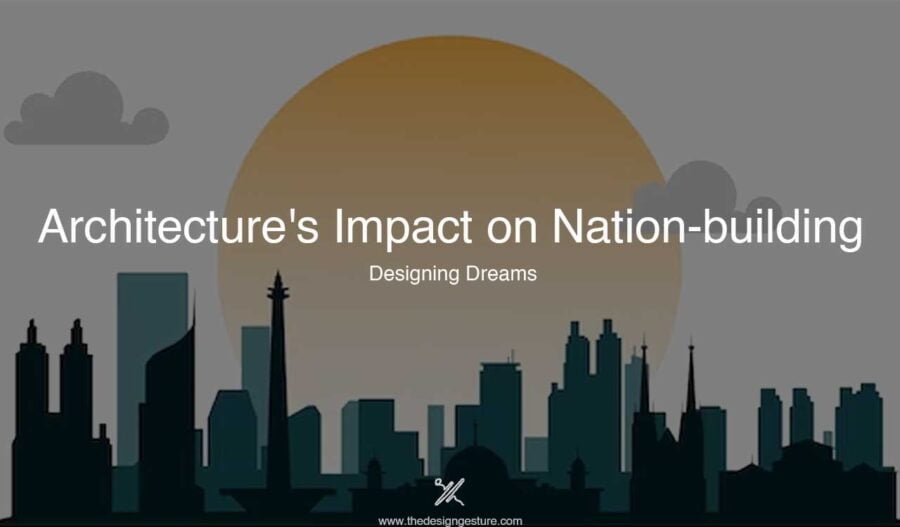The development of iconic structures, urban planning, sustainable development, and tourism will all be covered in this article because they all have a big impact on nation-building. In the creation of a nation, architecture performs a variety of significant and varied roles, from iconic structures that serve as markers of national pride to infrastructure projects that foster connection and economic growth.
In addition to affecting the beauty of a nation’s structures, architecture also has a significant impact on its social, cultural, and economic identities. A society can utilize architecture in addition to building actual structures to communicate its goals and bring its members together. Historical structures like the Great Pyramids of Egypt and cutting-edge architectural wonders like the Burj Khalifa in Dubai are examples of how architecture has influenced the growth and definition of nations.
Table of Contents
National Symbols and Landmarks
The development of iconic structures that serve as representations of a nation’s identity and cultural history is one of architecture’s key functions in the development of a society. These landmarks draw attention from all over the world, inspiring pride and patriotism, and frequently acting as important cultural and historical sites. For instance, India’s Taj Mahal, which draws millions of tourists each year, is a globally recognized icon of the nation. Such iconic buildings serve as powerful beacons that help establish a nation’s narrative on a worldwide scale, as well as serving as a showcase for its ingenuity.
Other famous buildings, such as the Sydney Opera House in Australia or the Eiffel Tower in France, are easily recognised and hold a particular place in the hearts of both people and visitors. They serve as powerful symbols of national pride, architectural skill, and cultural legacies.
Urban Planning
A nation’s beliefs, goals, and socioeconomic growth are reflected in the cities that are built thanks in large part to architecture. Architects contribute to the creation of sustainable and habitable communities by carefully considering infrastructure, public areas, and connections. Barcelona is a prime illustration of how urban planning can enhance the perception of a nation because of its tasteful fusion of modern and traditional architecture. The potential of architectural innovation to create greener, more effective urban environments is shown by smart city programmes like Singapore’s Gardens by the Bay.
Civic Buildings and Institutions
The constructed environment around public institutions including government buildings, museums, libraries, and schools is influenced by architecture. A nation’s principles and values are represented by these buildings, which also serve as functional areas. The United States Capitol in Washington, D.C., for instance, serves as a symbol of the democratic principles and polity of the nation. These buildings’ architectural and design features frequently convey the history and narrative of the nation.
Infrastructure Development
When building infrastructure, such as public buildings, airports, and roads, architecture plays a big part. These activities are necessary for a nation’s social, connectivity, and economic growth. The Burj Khalifa in Dubai, the Shanghai Maglev Train in China, and the High Line in New York City are examples of architectural interventions that have altered the urban environment. These buildings stand for development and innovation.
Sustainable and Resilient Design in Nation-building
Architects are embracing sustainable practises to create resilient nations with low energy consumption and little environmental impact as environmental challenges and climate change become increasingly prevalent on a global scale. Utilising renewable resources, creating designs that use less energy, and using green building practises are essential. The Bosco Verticale in Milan, a cutting-edge building that uses vertical forests to improve air quality and consume less energy, is a prime example of the potential of sustainable architecture in the growth of eco-aware nations.
Further evidence of the growing significance of sustainable architecture comes from the construction of green buildings like the Canadian Vancouver Convention Centre. By employing renewable energy sources, energy-efficient designs, and green technologies, architects are supporting nations in the transition to a future that is more ecologically conscious.
Cultural Preservation and Revitalization
Architecture plays a significant role in safeguarding cultural heritage through revitalising urban areas and restoring historic buildings. The reconstruction of the Acropolis in Athens, Greece, and the preservation of the Old City of Jerusalem are examples of how architecture maintains a nation’s historical past and ensures its transfer to future generations. These programmes promote a sense of national identity and pride.
Social Integration and Inclusivity
Architecture may promote social inclusion and integration by creating spaces that can accommodate many communities and foster interaction. Public parks, community centres, and mixed-use complexes are a few examples of architectural interventions that support social cohesion and connection. The High Line in New York City serves as an illustration of how architecture can provide warm places for social interaction. An abandoned elevated railway was transformed into a vibrant public place by The High Line.
Tourism
In addition to boosting the economy and promoting cross-cultural interaction, architectural icons frequently serve as tourist attractions. Millions of people visit the Taj Mahal in India each year, which is a UNESCO World Heritage Site, boosting the nation’s tourism business. Additionally, Bilbao, Spain’s Guggenheim Museum, which annually attracts millions of tourists and shows that architecture can be a driver for regional development and employment creation, completely changed the city’s economy.
Conclusion
It is unarguable that architecture plays a crucial role in the formation of nations. By creating famous monuments, architects help define a country’s identity and create emblems of national pride. Through urban planning, environmentally sustainable development, and tourism, architecture also supports a healthy society and economy. The examples given above demonstrate how architecture can significantly affect the physical, social, and cultural fabric of a nation. By expressing a society’s ideas, objectives, and collective memories through inventive design and meticulous planning, architecture can act as a tool for nation-building.
To conclude, as nations try to build a better future, the art and science of architecture will continue to be the foundation upon which the world is built, having a significant impact on following generations.




